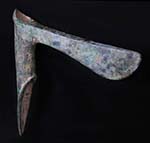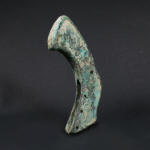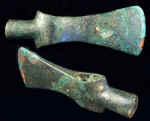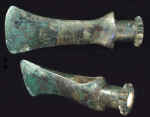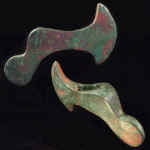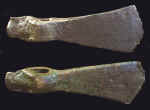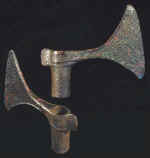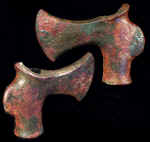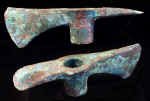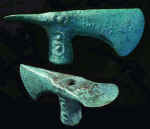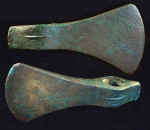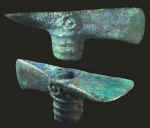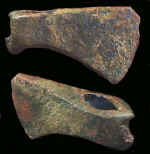Ancient weapons of the Bronze Age include axes, adzes, pick-axes and celts, many of which are also utilised in woodworking and agriculture. Copper and Bronze Age axes, adzes, saw, hoe below are from ancient cultures of Near East, Europe and Central Asia.
1323
Copper Age adze-axe
III Millennium B.C.
Iran
Cast. Solid bar with slightly convex sides and cutting edge. Lentoid longitudinal cross section.
Length 5.1"(12.9 cm), Width 2.2"(5.6 cm), Height 0.6"(1.5 cm).
For published examples see:
-Muscarella O. Bronze and Iron. Ancient Near Eastern Artifacts in the Metropolitan Museum of Art, MET, 1988, p. 81 no.144
-Deshayes J. Les outils de bronze, de L'indus au Danube (IVe au IIe Millenaire). Paris, 1960, pl. III, IV.
SOLD
1325
Bronze shaft-hole axe
III Millennium B.C.
Iran
Cast. Copper alloy with cylindrical long shaft-hole, base is sectioned away at the sharp angle and reinforced with a molding. On the rare of the socket is a longitudinal rib, forming a protuberance at the top.
L. 6.3"(16.0 cm), W. 6.5"(16.5 cm).
For published examples see:
- J. Deshayes, Les outils de bronze, de l’Indus au Danube (Paris, 1960), pl. 18, 1319; pl. 19, 1324, pl. 20, 1325.
- Stutzinger D., Mit Hieb und Stich Bronzewaffen aus dem alten Iran Die Sammlung von Gravert (Frakfurt am Main, 2008), p.50
- The British Museum, Splendours of Mesopotamia, London, British Museum Press, 2011, p.54, cat.31
- A. Godard, Les Bronzes du Luristan, Ars Asiatica 17 (Paris, 1931) nos. 39-41, pls. 14
- F. Tallon, Métallurgie susienne 1: De la fondation de Suse au XVIIIe siècle avant J.-C. (Paris, 1987), nos. 39-41
$ 1500
1332
Early Bronze Age ceremonial axe
III Millennium B.C.
Iran
Cast. Thick flat assimetrical axe head with curved blade and elliptical socket in the middle, projecting through the butt, with 4 rivets along the length from both sides. Raised ridge along head's perimeter on both side.
The patina is green, brown and red. The difference in patinas traces a handle that was once attached. The blade is rectangular in cross-section and not sharp. This axe was used as a ceremonial object.
Length 4.7"(12.0 cm), thickness 0.5"(1.3 cm).
For similar examples see:
- Stutzinger D., Mit Hieb und Stich Bronzewaffen aus dem alten Iran Die Sammlung von Gravert (Frakfurt am Main, 2008), p.58, cat.37
$ 750
1321
Bronze adze-axe
Iron Age III
Luristan
Cast. Adze-axe head with tall cylindrical shaft-hole socket and convex cutting edges perpendicular to each other. Socket decorated with three horizontal ridges at the bottom and at blade to blade level, undulating rope below and beaded pattern above.
L. 3.2"(8.2 cm), W. 6.0"(15.2 cm).
For published examples see:
- Haerinck and B. Overlaet, 1999, Djub-i Gauhar and Gul Khanan Murdah Iron Age III graveyards in the Aivan plain (Luristan Excavation Documents Vol. III), p. 168
- Deshayes J. Les outils de bronze, de L’indus au Danube (IVe au IIe Millenaire). Paris, 1960, pl. LIII no. 3132.
$ 900
1187
Bronze axe
III Millennium B.C.
Iran
Cast. Symmetrical in two planes, axe head with elliptical socket, with long cylindrical butt, terminated with a band of spiked notches. White, dense, calcium-based original material remains inside the butt. The blade broadens out towards the convex cutting edge.
L. 5.3"(13.5 cm), W. 1.1"(2.8 cm).
For related type see: Deshayes J. Les outils de bronze, de L'indus au Danube (IVe au IIe Millenaire). Paris, 1960, pl. XXV, #1573.
$ 975
1322
Bronze Age bronze saw
End of III-Early II Millennium B.C.
Iran
Thin (2 mm) curved blade with a short tang and small short teeth. Shaped by hammering.
L. 7.6"(19.4 cm), W. 1.8"(4.5 cm).
Saws are rare finds. See published examples below:
-E. Haerinck & B. Overlaet, The Early Bronze Age at Bani Surmah. Luristan Pusht-i Kuh (= Luristan Excavation Documents 6), Acta Iranica 43, Peeters/Leuven-Dudley (MA), p. 37
Deshayes J. Les outils de bronze, de L’indus au Danube (IVe au IIe Millenaire). Paris, 1960, pl. XLVIII.
$ 800
1188
Bronze axe
III Millennium B.C.
Iran
Cast. Symmetrical in two planes, axe head with elliptical socket, with long cylindrical butt, terminated with a band of spiked notches. White, dense, calcium-based original material remains inside the butt. The blade broadens out towards the convex cutting edge.
L. 5.3"(13.5 cm), W. 1.1"(2.8 cm).
For related type see: Deshayes J. Les outils de bronze, de L'indus au Danube (IVe au IIe Millenaire). Paris, 1960, pl. XXV, #1573.
$ 975
1189
Early Bronze Age axe
III Millennium B.C.
Iran
Cast. Axe head consisting of crescent-shaped blade and round butt-end with elliptical socket in the middle.
L. 5"(12.8 cm), W. 0.7"(1.8 cm).
$ 750
1192
Bronze axe
End of III - early II Millennium B.C.
Iran
IRAN Cast. Axe head with shaft-hole slightly flared at the bottom line. Beveled concave top. Protuberance on the butt. The blade is splayed out towards the convex cutting edge which has never been ground down for use.
L. 3.7"(9.5 cm), H. 2.7"(6.9 cm).
See: Deshayes J. Les outils de bronze, de L'indus au Danube (IVe au IIe Millenaire).
Paris, 1960, pl. XIX, #1340; Moorey P.R.S Catalog of the Ancient Persian Bronzes in the Ashmolean Museum. Oxford, 1971, p.44, # 8; Meier- Arendt W. Archäologische Reihe Bronzen und Keramik aus Luristan. Vol. 4. Frankfurt am Main, 1984, cat. 11
$ 475
1195
Bronze adze-axe
II Millennium B.C.
Cast. Adze-axe head with round socket. Wide blade set at an acute angle to the rhomboidal body, convex cutting edge.
L. 5.7"(14.4 cm), H. 2.7"(6.8 cm).
$ 475
1334
Bronze adze-axe
II Millennium B.C.
Iran
Cast. Adze-axe head with cylindrical shaft-hole decorated with three ridges. Convex cutting edges perpendicular to each other.
Length 6.6″(16.8 cm), Width 2.3″(5.8 cm).
For published examples of similar adze-axe see:
- Deshayes J. Les outils de bronze, de L’indus au Danube (IVe au IIe Millenaire). Paris, 1960, pl. XXXVIII, no. 2221; pl. LIII, no. 3123
- Moorey P.R.S Catalog of the Ancient Persian Bronzes in the Ashmolean Museum. Oxford, 1971, p.64.
$ 700
1180
Bronze adze-axe
Middle of II MillenniumB.C..
N. Iran
Cast. Large adze-axe head with round cross-section shaft-hole. Convex cutting edges perpendicular to each other..
L. 8.3"(21 cm), H. 2.6"(6.6 cm)..
See: Deshayes J. Les outils de bronze, de L'indus au Danube (IVe au IIe Millenaire)..
Paris, 1960, pl. LIII, #3122; ; Moorey P.R.S Catalog of the Ancient Persian Bronzes in the Ashmolean Museum. Oxford, 1971, p.64..
$ 500
1193
Bronze adze-axe
1200-900 B.C.
Amlash
Cast. Adze-axe head with short cylindrical shaft-hole decorated with ridges. Opposed concentric circles above ridges.
L. 4.8"(12.3 cm), H. 1.7"(4.3 cm).
See: Meier- Arendt W. Archäologische Reihe Bronzen und Keramik aus Luristan. Vol. 4. Frankfurt am Main, 1984, cat. 71; Deshayes J. Les outils de bronze, de L'indus au Danube (IVe au IIe Millenaire). Paris, 1960, pl. LXVII, 3; Moorey P.R.S Catalog of the Ancient Persian Bronzes in the Ashmolean Museum. Oxford, 1971, p.64.
$ 475
1194
Bronze axe
II Millennium B.C.
Cast. Axe head with with elliptical socket. The blade broadens out towards the convex cutting edge, upper and lower edges of the blade are beveled.
L. 3.3"(8.3 cm), H. 1.8"(4.6 cm).
$ 250
1318
Bronze lugged axe
II Millennium B.C.
Iran
Flat, cast in open mold. Bi-concave symmetrical blade with convex cutting edge. Rectangular butt is flanked by blades shoulders. Belongs to Lugged axe type, however many scholars have suggested multiple functions for these blades as tools for woodworking and as weapons.
L. 6.4"(16.3 cm), H. 0.5"(1.2 cm), W. 1.9"(4.7 cm)
$ 400
1335
Bronze age battle axe
Central Asia, Inner Mongolia
XII-XI century B.C.
Cast in one piece forming a curve. Long blade, thickening at top and bottom as prominent transverse ridges, terminated by shaft-hole. The opposite side is square in cross section, gradually coming to the point. Both sides of this part are engraved with typical highly stylized deer antlers ornament.
Length 9.9" (25.2 cm).


